
Enchanting Christmas Market Trip to Bavaria & Prague with Gabriella-Maria
 10 Day Tour of Munich, Nuremberg and Prague
10 Day Tour of Munich, Nuremberg and Prague
Overview
Trip Map
Itinerary
Inclusions
Reviews







10 Days 9 Nights
Best Time: Nov-Dec
History Buffs
Exploring Scenic Countryside
Experience the season's enchantment with this exclusive Christmas Magic tour through Germany and Czech Republic. Explore the oldest and most iconic Christmas Markets, journey along Germany's Romantic Road, and delve into the winter wonderland of the Bavarian Alps. The tour includes 1st-class train journeys, private guided tours, dinner reservations and stays in boutique four-star hotels. Curated by influencer Gabriella-Maria Hafner, join her on the special December 6th, 2024 departure for an unforgettable festive adventure. With detailed travel guidance from Go Real Travel’s mobile app, every moment will be a holiday delight.
- Wander through Munich's Altstadt, exploring its historical charm and festive markets.
- Delight in the magical Nuremberg Christmas Markets, one of Germany's oldest and most famous.
- Marvel at the medieval beauty of Rothenburg ob der Tauber along the Romantic Road.
- Discover a winter-wonderland in the picturesque town of Garmisch-Partenkirchen in the Bavarian Alps.
- Stroll through Vienna’s Inner City & visit the splendid Schönbrunn Palace and its Christmas Market.
Experience the season's enchantment with this exclusive Christmas Magic tour through Germany and Czech Republic. Explore the oldest and most iconic Christmas Markets, journey along Germany's Romantic Road, and delve into the winter wonderland of the Bavarian Alps. The tour includes 1st-class train journeys, private guided tours, dinner reservations and stays in boutique four-star hotels. Curated by influencer Gabriella-Maria Hafner, join her on the special December 6th, 2024 departure for an unforgettable festive adventure. With detailed travel guidance from Go Real Travel’s mobile app, every moment will be a holiday delight.
- Wander through Munich's Altstadt, exploring its historical charm and festive markets.
- Delight in the magical Nuremberg Christmas Markets, one of Germany's oldest and most famous.
- Marvel at the medieval beauty of Rothenburg ob der Tauber along the Romantic Road.
- Discover a winter-wonderland in the picturesque town of Garmisch-Partenkirchen in the Bavarian Alps.
- Stroll through Vienna’s Inner City & visit the splendid Schönbrunn Palace and its Christmas Market.

Old Town
Architecture

Residence Palace
Castles & Chateaux

Deutsches Museum
Museums & Galleries

Nuremberg Castle
Castles & Chateaux

Nazi Rally Grounds
The Great War & WWII

Old Town
Historic Landmarks
Must see sights

Old Town
Architecture

Residence Palace
Castles & Chateaux

Deutsches Museum
Museums & Galleries

Nuremberg Castle
Castles & Chateaux

Nazi Rally Grounds
The Great War & WWII

Old Town
Historic Landmarks
Starting from
$3250
per person
 Not included
Not included Secure Your Customizable Trip
Enter your details to embark on a journey that can be tailored just for you.
Start
Travelers
0 travelers
Add Room
Remove Room
Preferred Hotel Stars
Select Hotel Stars
Craft Your Own Itinerary
Select your interests and destinations for a trip plan inspired by you.
Christmas Market Magic Trip - Map & Itinerary
Enable/Disable Map Scrolling
Click To Make Map Interactive

Christmas Market Magic Trip Timeline
 Edit Details
Edit DetailsArrival
3 nights
Munich
Germany
Train: 1.5h
3 nights
Nuremberg
Germany
Shuttle: 4h
3 nights
Prague
Czech Republic
Departure
Day-By-Day Itinerary of Christmas Market Magic Trip

Day 1
Arrive Munich
Day 1
Arrive Munich



To Be Determined
Munich Airport Pickup
For your arrival in Munich, we will provide information on the customs and passport procedures. We will schedule a pick up for your flight's arrival time. You will be met in the terminal by a driver holding a sign with your name on it. The ride is for your party only - you will not be sharing a vehicle. The cost of the ride will be included in your itinerary package. You will be taken directly to your hotel. IMPORTANT NOTE: Please be aware the car service can fit up to 1 checked item of luggage and 1 personal item per person, such as a purse or small backpack. If you think you will have more baggage, please inform your travel consultant as this may result in an additional fee.

Day 1
Arrive Munich


Day 1
Arrive Munich




To Be Determined:
Munich Airport Pickup
Afternoon to Early Evening:
Altstadt
Early Evening/Evening:
Augustiner Keller


Day 2
Munich
Day 2
Munich



9:00 AM - 11:30 AM
Guided Walk Tour of Historic Munich
Munich contains many reminders of a long and varied history but also encompasses the modern features of a strong and vibrant city. The insights of a local help make sense of the traditions, trends, and promises of Bavaria's Capital - sometimes referred to as the city of laptops and lederhosen. On this tour, your guide will show you the highlights of Munich and point out the many hidden treasures.

Day 2
Munich


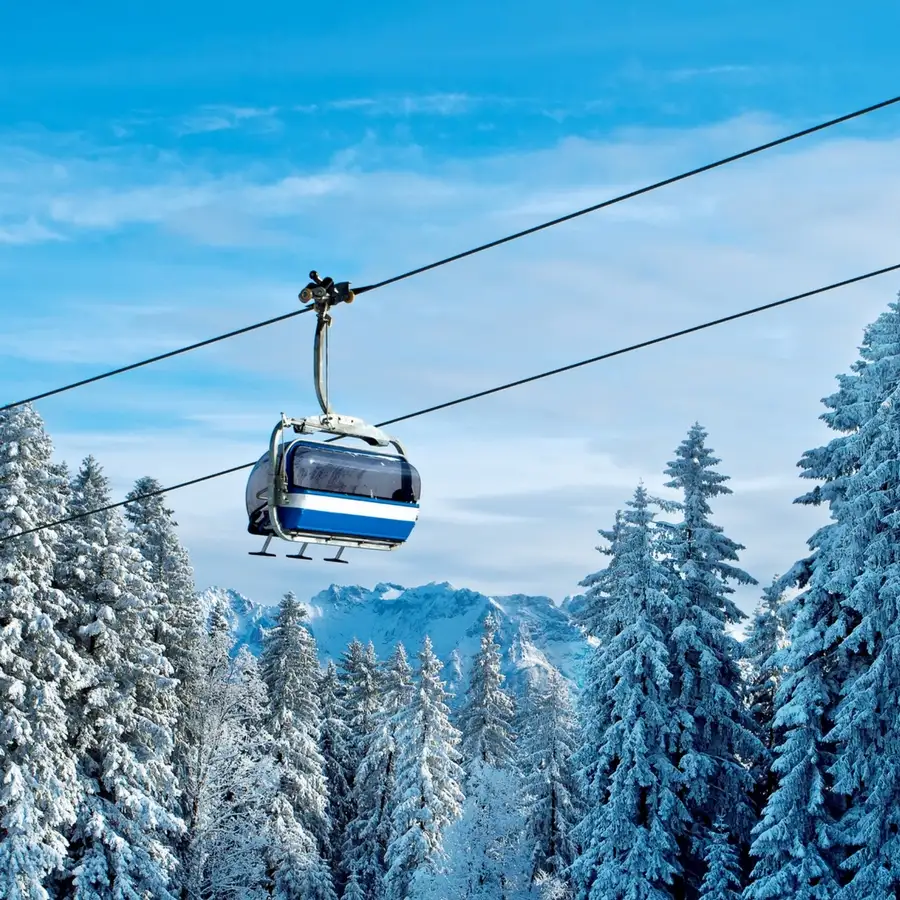
Day 3
Munich
Day 3
Munich

Morning to Late Afternoon
Excursion to Garmisch-Partenkirchen
Nestled in a magnificent setting at the foot of the Bavarian Alps, Garmisch-Partenkirchen is the German capital of summer hiking. The town has also been on the international winter-sports map ever since hosting the 1936 Winter Olympics. Once two different villages, Garmisch and Partenkirchen, the two halves of the town do show sharply contrasting characters: Garmisch is lively and international (in winter at least), while Partenkirchen better preserves its original Alpine charm. Perhaps the biggest draw for tourists is the opportunity to ride the famous Zugspitzbahn railway to Germany's tallest mountain, the Zugspitze.

Eibsee Lake
Hike to one of Bavaria's most picturesque spots.
Show More

Partnach Gorge
Venture deep within a stunning Alpine gorge.
Show More

Zugspitze
Take a ride on the famous Zugspitzbahn railway and a cable car to the peak of Germany's tallest mountain, the Zugspitze (2,962m or 9,718ft) for some truly breath-taking views.
Show More

Eibsee Lake
Hike to one of Bavaria's most picturesque spots.
Show More

Partnach Gorge
Venture deep within a stunning Alpine gorge.
Show More

Zugspitze
Take a ride on the famous Zugspitzbahn railway and a cable car to the peak of Germany's tallest mountain, the Zugspitze (2,962m or 9,718ft) for some truly breath-taking views.
Show More

Eibsee Lake
Hike to one of Bavaria's most picturesque spots.
Show More
prev
next

Day 3
Munich

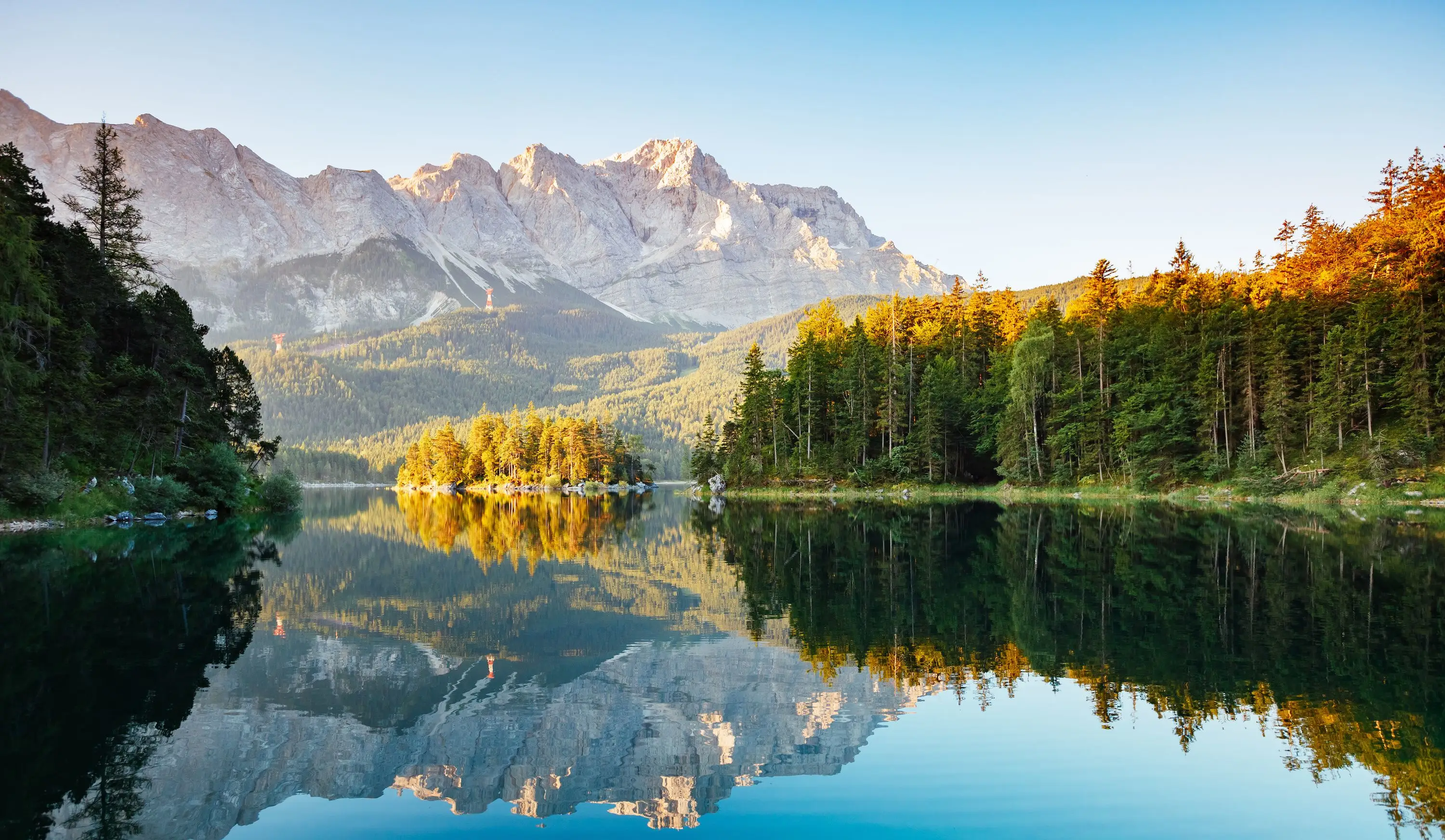
Eibsee Lake
 Highlight of Excursion to Garmisch-Partenkirchen
Highlight of Excursion to Garmisch-PartenkirchenHike to one of Bavaria's most picturesque spots.
If hiking is one of your goals in Garmisch and you're looking for a gentle option after descending from Zugspitze (or you don't wish to ascend the mountain at all), then we can heartily recommend the Eibsee Lake, which is, of course, one of the stops on the Zugspitzbahn. Just follow the signs to the lake (you can't miss it) and then the signs for the gentle 7.5km (4.6mi) hike around the lake shore while soaking up the stunning views. Avail yourself of the Eibsee beer garden after you get back to cool down.

Partnach Gorge
 Highlight of Excursion to Garmisch-Partenkirchen
Highlight of Excursion to Garmisch-PartenkirchenVenture deep within a stunning Alpine gorge.
If you want to avoid the expense of the Zugspitzbahn, then an excellent short or long hiking option is to head south of the train station to the Partnachklamm (Partnach Gorge). The trail to the gorge starts from the Olympic Ski Stadium, which if you need to save time you can get to by city bus no.1 or no.2 directly from the train station rather walking 2km (1.25mi) to Skistadion. From there you follow the signs to the gorge, which is only 30min away (you can also take a horse-drawn carriage from the stadium).
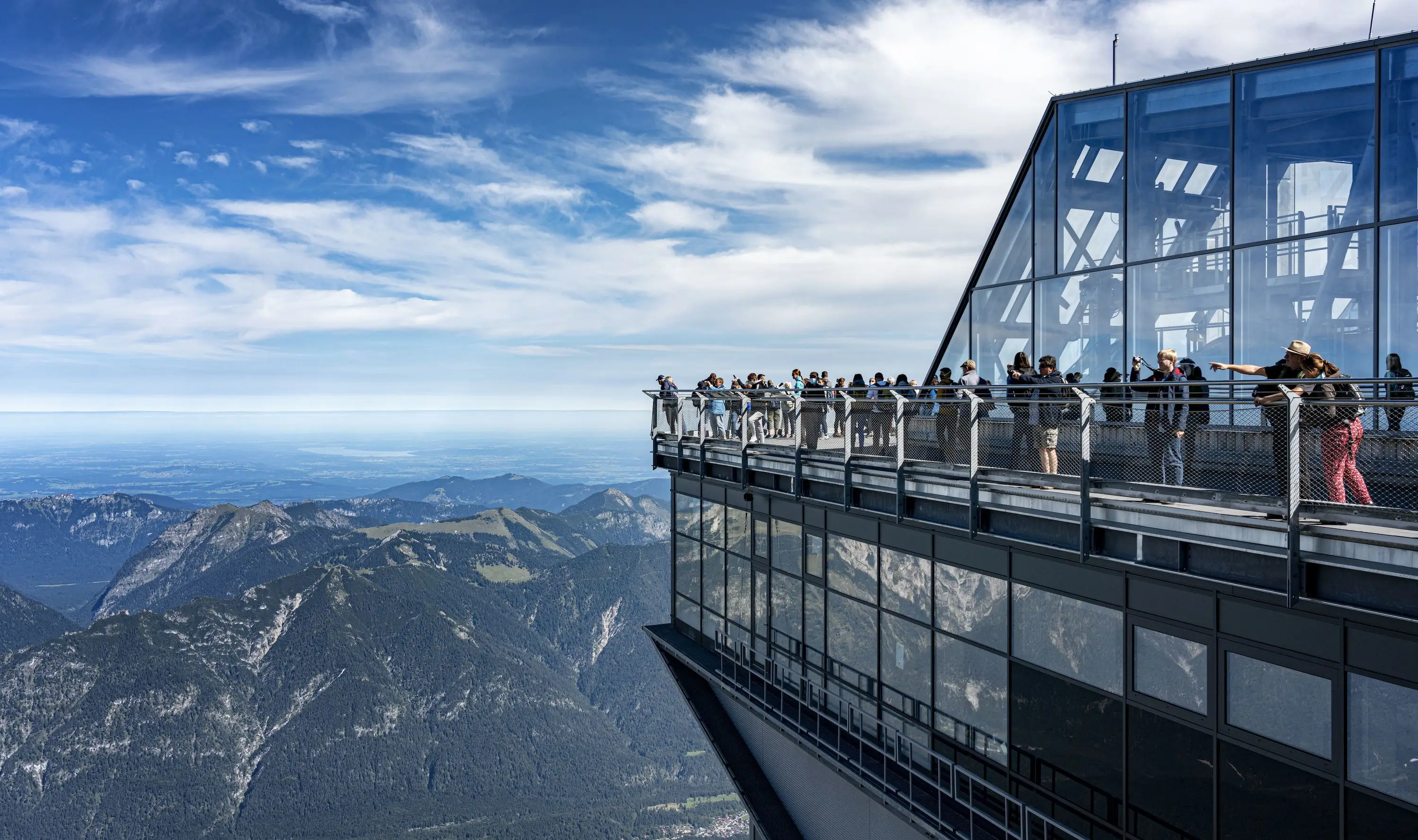
Zugspitze
 Highlight of Excursion to Garmisch-Partenkirchen
Highlight of Excursion to Garmisch-PartenkirchenTake a ride on the famous Zugspitzbahn railway and a cable car to the peak of Germany's tallest mountain, the Zugspitze (2,962m or 9,718ft) for some truly breath-taking views.
The Zugspitzbahn railway is the classic and breathtaking way of ascending Germany's highest peak, the Zugspitze (2962m or 9718ft). The line reaches as high as 2650m, making it the third-highest railway line in the world. The station and ticket office for the Zugspitzbahn trains (#3) is right beside the Garmisch-Partenkirchen train station. From here you take the purpose-built train along a cogwheel railway as far as Grainau - don't miss the wonderfully picturesque Pfarrkirche church that comes into view on the left as you near Grainau. In Grainau you'll change to a railcar that operates a rack-and-pinion system. The final 11.5km (7.1mi) gets steeper and steeper until you get just past the Eibsee station where you enter the 975m (3199ft) 'Rosi Tunnel'. You finally emerge at the Zugspitzplatt plateau on the Schneefen glacier below the Zugspitze peak. From there you journey to the summit on the ultramodern Gletscherbahn cable car (no extra ticket needed).

Eibsee Lake
 Highlight of Excursion to Garmisch-Partenkirchen
Highlight of Excursion to Garmisch-PartenkirchenHike to one of Bavaria's most picturesque spots.
If hiking is one of your goals in Garmisch and you're looking for a gentle option after descending from Zugspitze (or you don't wish to ascend the mountain at all), then we can heartily recommend the Eibsee Lake, which is, of course, one of the stops on the Zugspitzbahn. Just follow the signs to the lake (you can't miss it) and then the signs for the gentle 7.5km (4.6mi) hike around the lake shore while soaking up the stunning views. Avail yourself of the Eibsee beer garden after you get back to cool down.

Partnach Gorge
 Highlight of Excursion to Garmisch-Partenkirchen
Highlight of Excursion to Garmisch-PartenkirchenVenture deep within a stunning Alpine gorge.
If you want to avoid the expense of the Zugspitzbahn, then an excellent short or long hiking option is to head south of the train station to the Partnachklamm (Partnach Gorge). The trail to the gorge starts from the Olympic Ski Stadium, which if you need to save time you can get to by city bus no.1 or no.2 directly from the train station rather walking 2km (1.25mi) to Skistadion. From there you follow the signs to the gorge, which is only 30min away (you can also take a horse-drawn carriage from the stadium).

Zugspitze
 Highlight of Excursion to Garmisch-Partenkirchen
Highlight of Excursion to Garmisch-PartenkirchenTake a ride on the famous Zugspitzbahn railway and a cable car to the peak of Germany's tallest mountain, the Zugspitze (2,962m or 9,718ft) for some truly breath-taking views.
The Zugspitzbahn railway is the classic and breathtaking way of ascending Germany's highest peak, the Zugspitze (2962m or 9718ft). The line reaches as high as 2650m, making it the third-highest railway line in the world. The station and ticket office for the Zugspitzbahn trains (#3) is right beside the Garmisch-Partenkirchen train station. From here you take the purpose-built train along a cogwheel railway as far as Grainau - don't miss the wonderfully picturesque Pfarrkirche church that comes into view on the left as you near Grainau. In Grainau you'll change to a railcar that operates a rack-and-pinion system. The final 11.5km (7.1mi) gets steeper and steeper until you get just past the Eibsee station where you enter the 975m (3199ft) 'Rosi Tunnel'. You finally emerge at the Zugspitzplatt plateau on the Schneefen glacier below the Zugspitze peak. From there you journey to the summit on the ultramodern Gletscherbahn cable car (no extra ticket needed).

Eibsee Lake
 Highlight of Excursion to Garmisch-Partenkirchen
Highlight of Excursion to Garmisch-PartenkirchenHike to one of Bavaria's most picturesque spots.
If hiking is one of your goals in Garmisch and you're looking for a gentle option after descending from Zugspitze (or you don't wish to ascend the mountain at all), then we can heartily recommend the Eibsee Lake, which is, of course, one of the stops on the Zugspitzbahn. Just follow the signs to the lake (you can't miss it) and then the signs for the gentle 7.5km (4.6mi) hike around the lake shore while soaking up the stunning views. Avail yourself of the Eibsee beer garden after you get back to cool down.
prev
next

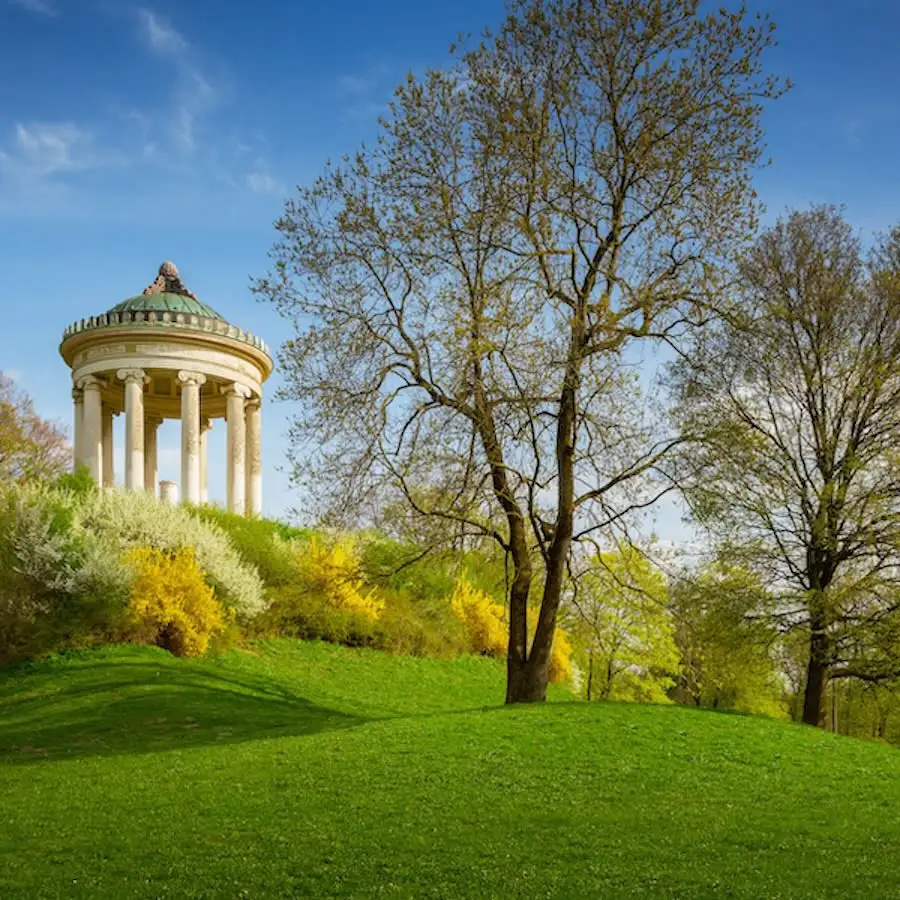
Day 4
Munich to Nuremberg
Day 4
Munich to Nuremberg






Early Morning/Morning
English Gardens
The English Garden is one of Europe's largest parks; in fact, it is larger than New York's Central Park. While it is called the "English Garden" after the style of the park, it was actually designed by an American-Englishman and is now a symbol of the very Bavarian city of Munich. The park is a perfect place to escape the city for a long stroll, where you can enjoy the natural scenery and the people watching.

Chinese Tower
Enjoy some Bavarian brews with the locals in Munich's second largest beer garden.
Show More

Eisbachwelle
Watch surfers catch some waves in the middle of the city.
Show More

Chinese Tower
Enjoy some Bavarian brews with the locals in Munich's second largest beer garden.
Show More

Eisbachwelle
Watch surfers catch some waves in the middle of the city.
Show More

Chinese Tower
Enjoy some Bavarian brews with the locals in Munich's second largest beer garden.
Show More

Eisbachwelle
Watch surfers catch some waves in the middle of the city.
Show More
prev
next

Day 4
Munich to Nuremberg


Chinese Tower
 Highlight of English Gardens
Highlight of English GardensEnjoy some Bavarian brews with the locals in Munich's second largest beer garden.
Located in the middle of the English Gardens, this beer garden (7,000 seats) is located beneath the wooden Chinese Tower. The 25 meter high (75 feet) pagoda was built in 1789 during a pan-European craze for all things East Asian. The food stalls around the pagoda offer traditional beer garden food such as Steckerlfisch (grilled fish on a stick), Hendl (roasted chicken) and Schweinshaxn (roasted pork knuckle). The beer served is Hofbräu and a Maß Hell (lager).
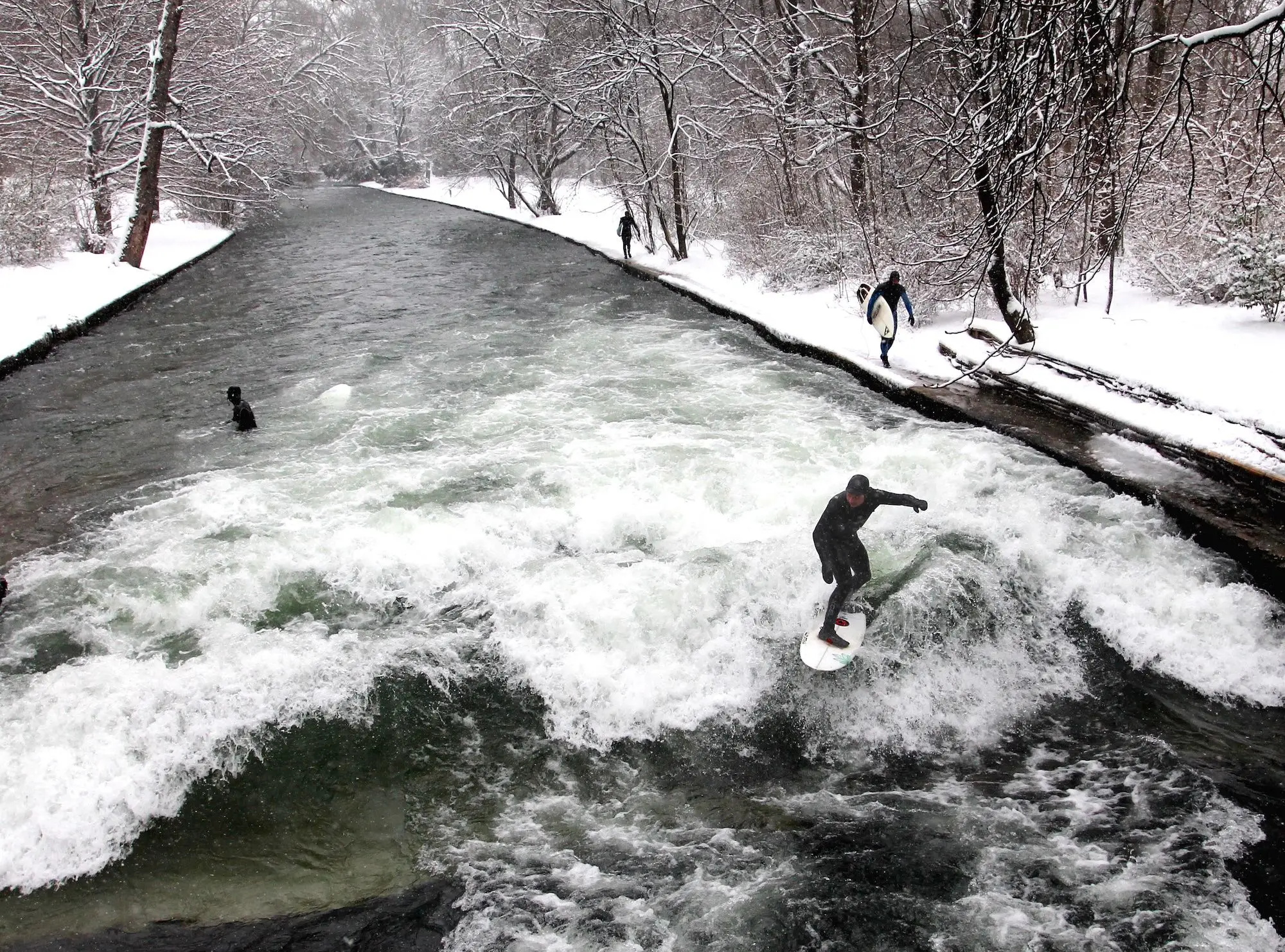
Eisbachwelle
 Highlight of English Gardens
Highlight of English GardensWatch surfers catch some waves in the middle of the city.
At the extreme southern end of the park you can find one of the more unusual and entertaining pastimes enjoyed by the locals - surfing on the man-made Eisbach river. There is a standing wave produced by the water pumping mechanism and surfers line up along the bank taking turns entering the water with their boards. After a minute or so, successful surfers will voluntarily drop out, returning to the end of the line allowing the next person in line an opportunity. The water is cold and shallow (sometimes only 40 cm deep), making it suitable only for experienced surfers.

Chinese Tower
 Highlight of English Gardens
Highlight of English GardensEnjoy some Bavarian brews with the locals in Munich's second largest beer garden.
Located in the middle of the English Gardens, this beer garden (7,000 seats) is located beneath the wooden Chinese Tower. The 25 meter high (75 feet) pagoda was built in 1789 during a pan-European craze for all things East Asian. The food stalls around the pagoda offer traditional beer garden food such as Steckerlfisch (grilled fish on a stick), Hendl (roasted chicken) and Schweinshaxn (roasted pork knuckle). The beer served is Hofbräu and a Maß Hell (lager).

Eisbachwelle
 Highlight of English Gardens
Highlight of English GardensWatch surfers catch some waves in the middle of the city.
At the extreme southern end of the park you can find one of the more unusual and entertaining pastimes enjoyed by the locals - surfing on the man-made Eisbach river. There is a standing wave produced by the water pumping mechanism and surfers line up along the bank taking turns entering the water with their boards. After a minute or so, successful surfers will voluntarily drop out, returning to the end of the line allowing the next person in line an opportunity. The water is cold and shallow (sometimes only 40 cm deep), making it suitable only for experienced surfers.

Chinese Tower
 Highlight of English Gardens
Highlight of English GardensEnjoy some Bavarian brews with the locals in Munich's second largest beer garden.
Located in the middle of the English Gardens, this beer garden (7,000 seats) is located beneath the wooden Chinese Tower. The 25 meter high (75 feet) pagoda was built in 1789 during a pan-European craze for all things East Asian. The food stalls around the pagoda offer traditional beer garden food such as Steckerlfisch (grilled fish on a stick), Hendl (roasted chicken) and Schweinshaxn (roasted pork knuckle). The beer served is Hofbräu and a Maß Hell (lager).

Eisbachwelle
 Highlight of English Gardens
Highlight of English GardensWatch surfers catch some waves in the middle of the city.
At the extreme southern end of the park you can find one of the more unusual and entertaining pastimes enjoyed by the locals - surfing on the man-made Eisbach river. There is a standing wave produced by the water pumping mechanism and surfers line up along the bank taking turns entering the water with their boards. After a minute or so, successful surfers will voluntarily drop out, returning to the end of the line allowing the next person in line an opportunity. The water is cold and shallow (sometimes only 40 cm deep), making it suitable only for experienced surfers.
prev
next

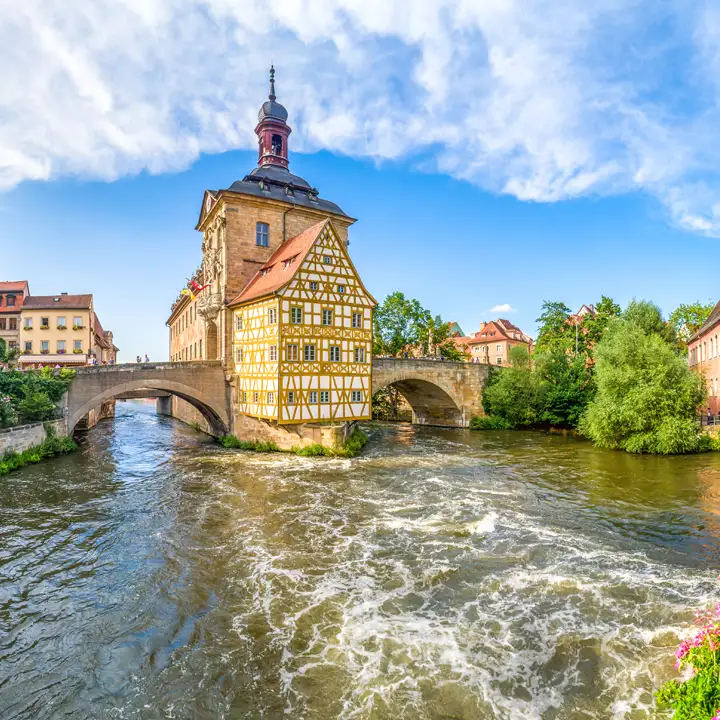
Day 5
Nuremberg
Day 5
Nuremberg


Early Morning to Afternoon
Bamberg
Nicknamed the “Franconian Rome”, Bamberg is an architectural masterpiece, located just a 40-minute scenic train journey from Nuremberg. Spread over seven hills and divided by the Regnitz River, this charming town is one of Bavaria’s best. Picture perfect around every corner, Bamberg has one of Europe’s largest intact old town centers with its entire Altstadt a UNESCO World Heritage Site.

Little Venice (Klein Venedig)
Relax by the river in this charming local neighborhood known as Little Venice.
Show More

Schloss Seehof
Take a short trip just outside the town to an elegant summer palace with extensive gardens.
Show More

Altenburg Castle
Take a pleasant walk through the woods to this usually undiscovered castle overlooking the city.
Show More

Neue Residenz & Cathedral
Be sure not to miss the two most monumental architectural acheivements of the Prince-Bishops of Bamberg.
Show More

Old Town Hall
See the most iconic building in Bamberg, precariously perched on an island in the river.
Show More

Little Venice (Klein Venedig)
Relax by the river in this charming local neighborhood known as Little Venice.
Show More

Schloss Seehof
Take a short trip just outside the town to an elegant summer palace with extensive gardens.
Show More

Altenburg Castle
Take a pleasant walk through the woods to this usually undiscovered castle overlooking the city.
Show More

Neue Residenz & Cathedral
Be sure not to miss the two most monumental architectural acheivements of the Prince-Bishops of Bamberg.
Show More

Old Town Hall
See the most iconic building in Bamberg, precariously perched on an island in the river.
Show More

Little Venice (Klein Venedig)
Relax by the river in this charming local neighborhood known as Little Venice.
Show More
prev
next

Day 5
Nuremberg

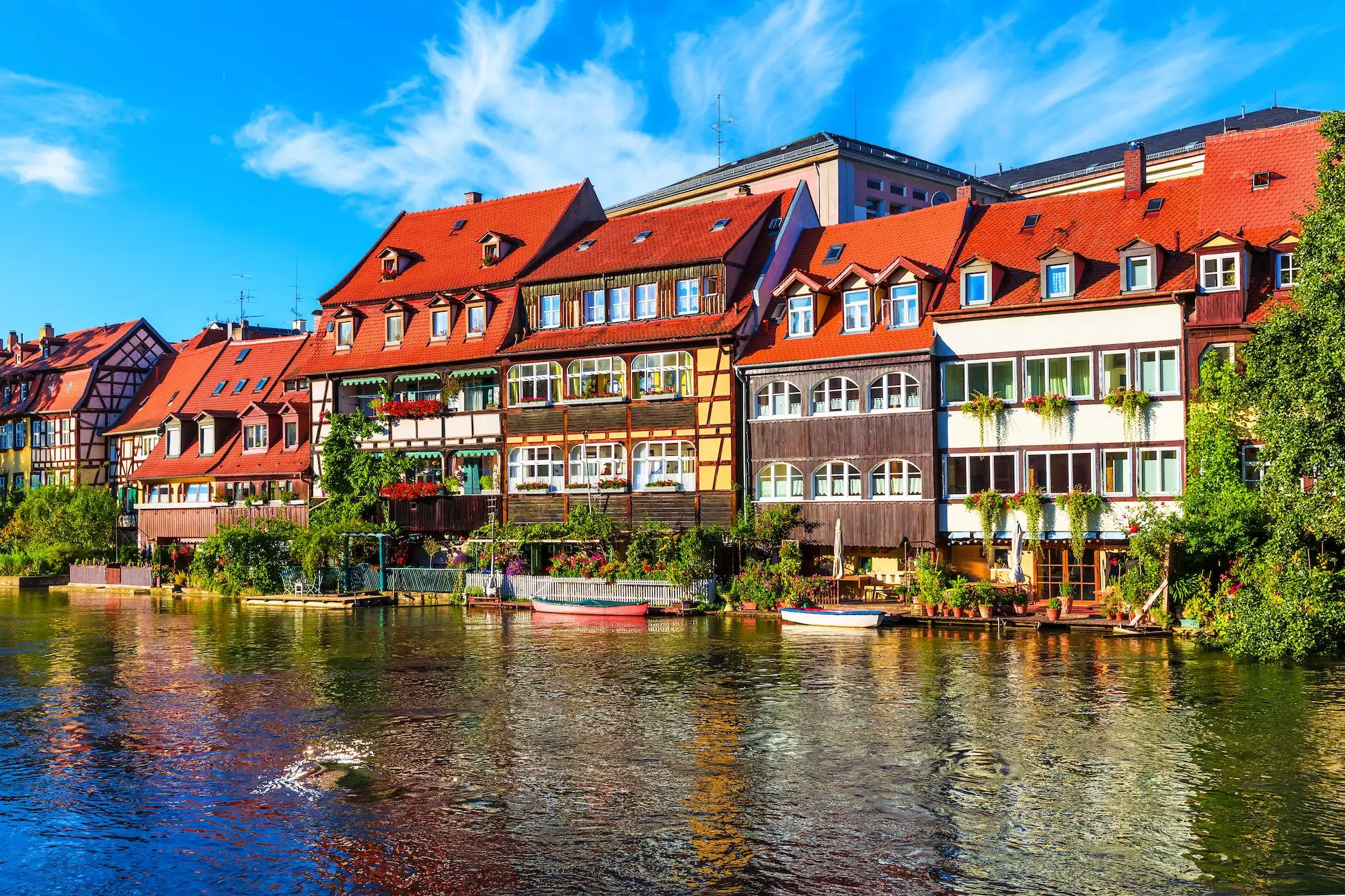
Little Venice (Klein Venedig)
 Highlight of Bamberg
Highlight of BambergRelax by the river in this charming local neighborhood known as Little Venice.
The former fishermen’s district located on the east bank of the Regnitz River is locally known as Little Venice. Fronted by tiny gardens and terraces, these charming half-timbered buildings date back to the Middle Ages, and are a delight to wander around especially in the summer. Good vantage points include the Untere Brücke near the Altes Rathaus, and on a cruise down the river.

Schloss Seehof
 Highlight of Bamberg
Highlight of BambergTake a short trip just outside the town to an elegant summer palace with extensive gardens.
Built from 1686 as a summer residence for the Bamberg Prince-Bishops, Schloss Seehof is a beautiful palace located just a short bus ride from the center of Bamberg. Its four domed towers mark the symmetrical building that lies within extensive gardens that were added later by other prince-bishops who resided in the castle. Within the palace are magnificent state rooms that maintain their 17th and 18th century period features and details. These can only be visited on a guided tour. Surrounding the palace are beautiful gardens complete with fountains, sculptures, and orangery.

Altenburg Castle
 Highlight of Bamberg
Highlight of BambergTake a pleasant walk through the woods to this usually undiscovered castle overlooking the city.
Dating back to the early 12th century, the castle was originally a fortress, used as a refuge for the townspeople. It was later converted into a castle in the 18th century by Frederick II and Frederick III. Today you can walk to the castle from the center of Bamberg and enjoy beautiful views of the city of Bamberg as well as tour the castle's interior. Note
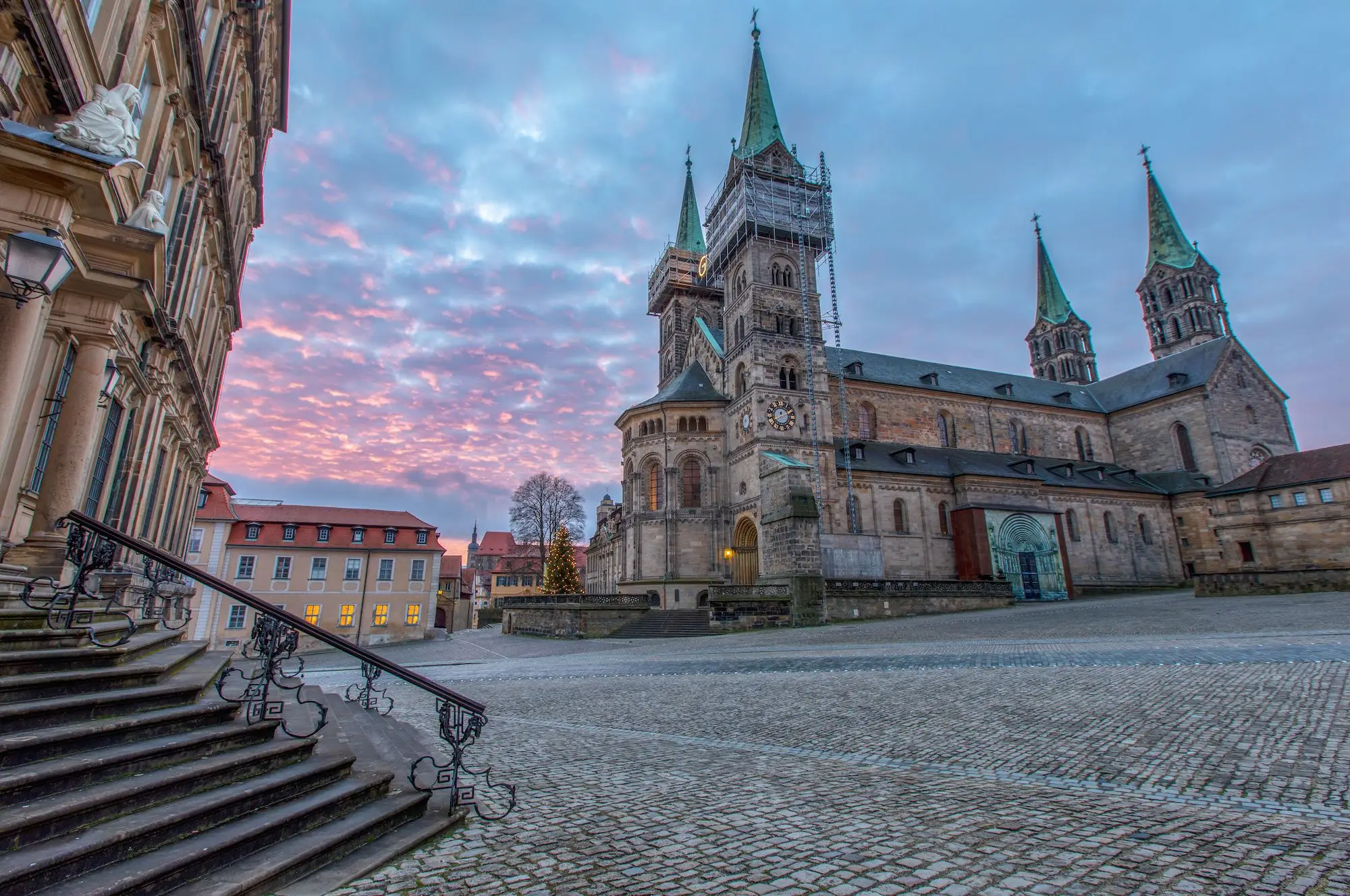
Neue Residenz & Cathedral
 Highlight of Bamberg
Highlight of BambergBe sure not to miss the two most monumental architectural acheivements of the Prince-Bishops of Bamberg.
Built between 1695-1704, the New Residence consists of over 40 magnificent room adorned with stucco ceilings, period furniture, rugs and art from the 17th and 18th centuries. The imperial hall, the elector's rooms and the prince-bishops' apartments are particularly worth seeing. You should also save time for the courtyard and rose-garden, with over 4500 roses, historic statues and wonderful views across the roofs of Bamberg. Next door to the Residence is one of the most famous sacred-buildings in Germany, the Bamberg Cathedral. Endowed with a Romanesque-Gothic style, four majestic spires, and beautiful vaulted ceilings, it holds the tombs of Emperor Henry II and Pope Clement II, the only papal burial ground north of the Alps. Also of interest is the Diocesan Museum with the cathedral treasury, old vestments (including Henry II's imperial robes), and statues.

Old Town Hall
 Highlight of Bamberg
Highlight of BambergSee the most iconic building in Bamberg, precariously perched on an island in the river.
According to legend, it was built on an artificial island because the bishop of Bamberg would not grant the citizens any land for its construction. It is one of the most beautiful buildings in the Old Town, particularly due to its wonderful frescoes that depict the story of how the building came to be built on the island.

Little Venice (Klein Venedig)
 Highlight of Bamberg
Highlight of BambergRelax by the river in this charming local neighborhood known as Little Venice.
The former fishermen’s district located on the east bank of the Regnitz River is locally known as Little Venice. Fronted by tiny gardens and terraces, these charming half-timbered buildings date back to the Middle Ages, and are a delight to wander around especially in the summer. Good vantage points include the Untere Brücke near the Altes Rathaus, and on a cruise down the river.

Schloss Seehof
 Highlight of Bamberg
Highlight of BambergTake a short trip just outside the town to an elegant summer palace with extensive gardens.
Built from 1686 as a summer residence for the Bamberg Prince-Bishops, Schloss Seehof is a beautiful palace located just a short bus ride from the center of Bamberg. Its four domed towers mark the symmetrical building that lies within extensive gardens that were added later by other prince-bishops who resided in the castle. Within the palace are magnificent state rooms that maintain their 17th and 18th century period features and details. These can only be visited on a guided tour. Surrounding the palace are beautiful gardens complete with fountains, sculptures, and orangery.

Altenburg Castle
 Highlight of Bamberg
Highlight of BambergTake a pleasant walk through the woods to this usually undiscovered castle overlooking the city.
Dating back to the early 12th century, the castle was originally a fortress, used as a refuge for the townspeople. It was later converted into a castle in the 18th century by Frederick II and Frederick III. Today you can walk to the castle from the center of Bamberg and enjoy beautiful views of the city of Bamberg as well as tour the castle's interior. Note

Neue Residenz & Cathedral
 Highlight of Bamberg
Highlight of BambergBe sure not to miss the two most monumental architectural acheivements of the Prince-Bishops of Bamberg.
Built between 1695-1704, the New Residence consists of over 40 magnificent room adorned with stucco ceilings, period furniture, rugs and art from the 17th and 18th centuries. The imperial hall, the elector's rooms and the prince-bishops' apartments are particularly worth seeing. You should also save time for the courtyard and rose-garden, with over 4500 roses, historic statues and wonderful views across the roofs of Bamberg. Next door to the Residence is one of the most famous sacred-buildings in Germany, the Bamberg Cathedral. Endowed with a Romanesque-Gothic style, four majestic spires, and beautiful vaulted ceilings, it holds the tombs of Emperor Henry II and Pope Clement II, the only papal burial ground north of the Alps. Also of interest is the Diocesan Museum with the cathedral treasury, old vestments (including Henry II's imperial robes), and statues.

Old Town Hall
 Highlight of Bamberg
Highlight of BambergSee the most iconic building in Bamberg, precariously perched on an island in the river.
According to legend, it was built on an artificial island because the bishop of Bamberg would not grant the citizens any land for its construction. It is one of the most beautiful buildings in the Old Town, particularly due to its wonderful frescoes that depict the story of how the building came to be built on the island.

Little Venice (Klein Venedig)
 Highlight of Bamberg
Highlight of BambergRelax by the river in this charming local neighborhood known as Little Venice.
The former fishermen’s district located on the east bank of the Regnitz River is locally known as Little Venice. Fronted by tiny gardens and terraces, these charming half-timbered buildings date back to the Middle Ages, and are a delight to wander around especially in the summer. Good vantage points include the Untere Brücke near the Altes Rathaus, and on a cruise down the river.
prev
next


Day 6
Nuremberg
Day 6
Nuremberg


Morning to Late Afternoon
Rothenburg
Massive stone walls studded with 42 towers; half-timbered colorful houses with red-tiled roofs; cobblestone streets and flower-filled window boxes: this is Rothenburg ob der Tauber, one of the most fairy-tale towns in all of Europe, and the most popular stop on Germany's famous "Romantic Road". This little slice of storybook heaven is one of the most photographed towns in Europe, with thousands of visitors from all over the world coming to experience its magical atmosphere. If traveling by train, it is located only a little more than an hour from Nuremberg, although you will need to make two connections on the journey.

Imperial Town Museum
Take a peek at what may be Germany's oldest kitchen and learn a bit of local lore and history.
Show More

Rothenburg City Wall
Peer over the red rooftops of Rothenburg as you walk its centuries-old battlements.
Show More

Christmas Store & German Christmas Museum
Experience a traditional German Christmas, regardless of when you visit.
Show More

Rothenburg Market Square
Stop for a coffee or beer and enjoy the ambience in this lovely square.
Show More

Plönlein (Little Square)
See one of the most photographed spots in Europe with your own eyes.
Show More

Imperial Town Museum
Take a peek at what may be Germany's oldest kitchen and learn a bit of local lore and history.
Show More

Rothenburg City Wall
Peer over the red rooftops of Rothenburg as you walk its centuries-old battlements.
Show More

Christmas Store & German Christmas Museum
Experience a traditional German Christmas, regardless of when you visit.
Show More

Rothenburg Market Square
Stop for a coffee or beer and enjoy the ambience in this lovely square.
Show More

Plönlein (Little Square)
See one of the most photographed spots in Europe with your own eyes.
Show More

Imperial Town Museum
Take a peek at what may be Germany's oldest kitchen and learn a bit of local lore and history.
Show More
prev
next

Day 6
Nuremberg


Imperial Town Museum
 Highlight of Rothenburg
Highlight of RothenburgTake a peek at what may be Germany's oldest kitchen and learn a bit of local lore and history.
Since 1936, the Imperial Town Museum located on Klosterhof street, has been housed in the former Dominican convent, which was dissolved in 1544. Visit the museum for an interesting experience of Rothenburg’s history and an impressive array of cultural artifacts and beautiful artwork. You can also visit the kitchen, which is said to date back to the late 1200s and is considered to be one of the oldest kitchens in Germany.

Rothenburg City Wall
 Highlight of Rothenburg
Highlight of RothenburgPeer over the red rooftops of Rothenburg as you walk its centuries-old battlements.
A must do while visiting Rothenburg is to take an hour or so to walk the historical walls around part of the Old Town. Stretching 2.5 miles (roughly 4km) around Rothenburg and guarded by 70 towers, walking around the covered ramparts of the Medieval City Wall is a magical experience. For those who wish to do a short section of the wall, you can start from the Rödertor Gateway which you may have passed through on entering the Old Town. For those adventurous travelers who wish to walk the whole wall, you can start from the Spitaltor, a massive round gatehouse located towards the south of the town, and continue to the final walkable gate, the Klingentor, located towards the north of the town. To start your walk, you simply need to climb the steep steps at the gate you wish to start. For those who are interested, a guided city wall tour is offered from the tourist information point next to the Market Square.
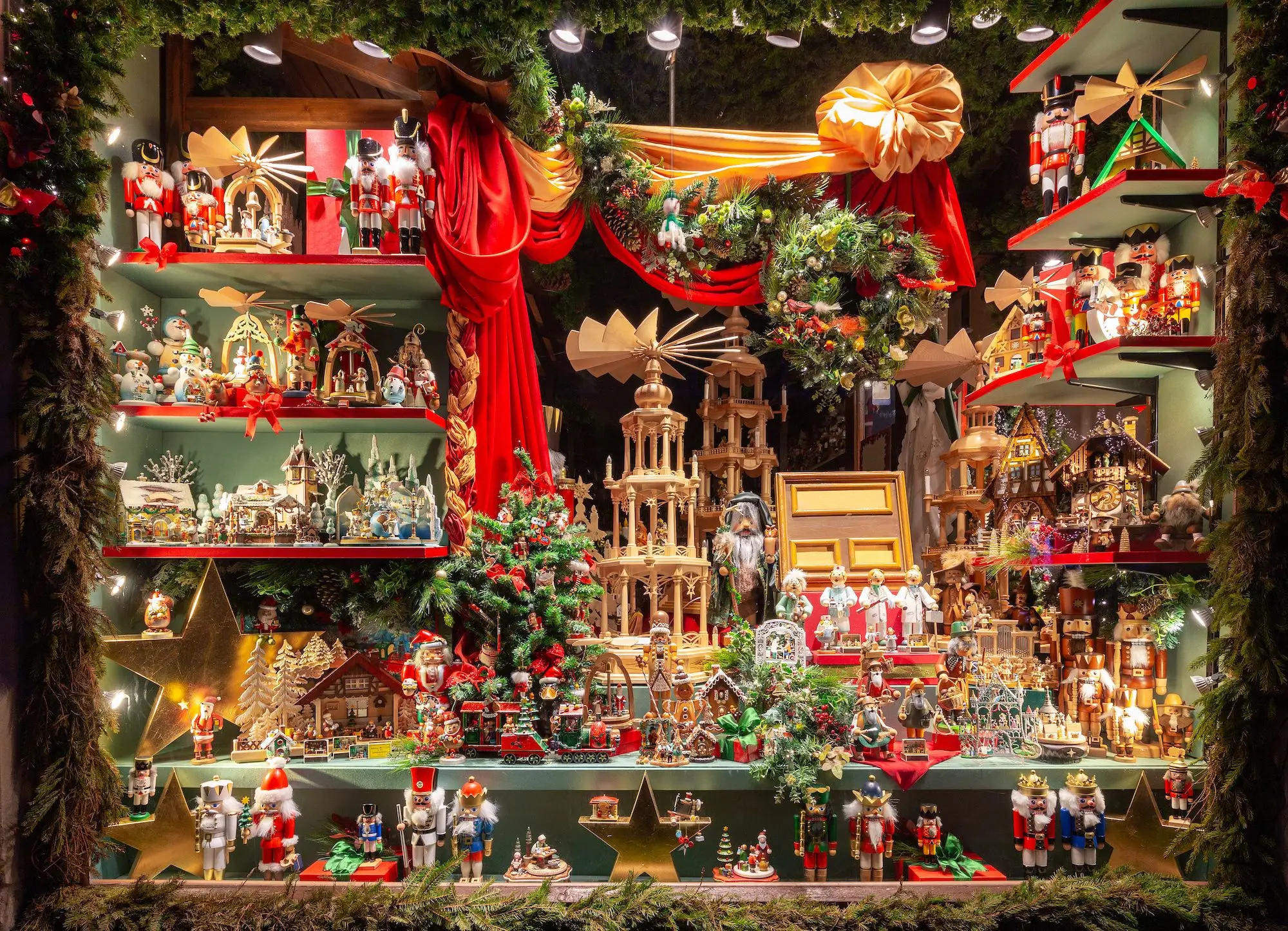
Christmas Store & German Christmas Museum
 Highlight of Rothenburg
Highlight of RothenburgExperience a traditional German Christmas, regardless of when you visit.
The famous Käthe Wohlfahrt Christmas decorations brand moved their flagship store in Rothenburg in 1977, and ever since, the town has been known for its unique Christmas Village and Museum. Next door to the store you will discover the German Christmas Museum. Covering over 2500 square foot, the museum covers hundreds of years of Christmas history and traditions in Germany.

Rothenburg Market Square
 Highlight of Rothenburg
Highlight of RothenburgStop for a coffee or beer and enjoy the ambience in this lovely square.
The Market Square and Old Town Hall, surrounded by splendid patrician houses, is where all the action takes places and where you will find the majority of the Christmas Stalls during Advent. The white Ratstrinkstube building to the right of the town hall features a red clock, where every hour between 10 am and 10 pm clockwork figures entertain visitors below. For one of the best view of Rothenburg, head up the Town Hall Tower. As one of the tallest towers in the Rothenburg, it was an important part of the historical city’s defense. The main purpose of the tower was to watch for fires, providing a quick and easy way to communicate with the city wall towers. We recommend only the physically fit attempt to conquer its 222 steps and steep ladder to the observational gallery.

Plönlein (Little Square)
 Highlight of Rothenburg
Highlight of RothenburgSee one of the most photographed spots in Europe with your own eyes.
You will surely recognize this small square known as the “Plönlein” (Little Square). It's narrow half-timbered building with a small fountain in front, framed by the Kobolzeller tower is one of the most famous postcard images of Rothenburg ob der Tauber. In the summer, hordes of tourists come to this spot to take the same obligatory photo.

Imperial Town Museum
 Highlight of Rothenburg
Highlight of RothenburgTake a peek at what may be Germany's oldest kitchen and learn a bit of local lore and history.
Since 1936, the Imperial Town Museum located on Klosterhof street, has been housed in the former Dominican convent, which was dissolved in 1544. Visit the museum for an interesting experience of Rothenburg’s history and an impressive array of cultural artifacts and beautiful artwork. You can also visit the kitchen, which is said to date back to the late 1200s and is considered to be one of the oldest kitchens in Germany.

Rothenburg City Wall
 Highlight of Rothenburg
Highlight of RothenburgPeer over the red rooftops of Rothenburg as you walk its centuries-old battlements.
A must do while visiting Rothenburg is to take an hour or so to walk the historical walls around part of the Old Town. Stretching 2.5 miles (roughly 4km) around Rothenburg and guarded by 70 towers, walking around the covered ramparts of the Medieval City Wall is a magical experience. For those who wish to do a short section of the wall, you can start from the Rödertor Gateway which you may have passed through on entering the Old Town. For those adventurous travelers who wish to walk the whole wall, you can start from the Spitaltor, a massive round gatehouse located towards the south of the town, and continue to the final walkable gate, the Klingentor, located towards the north of the town. To start your walk, you simply need to climb the steep steps at the gate you wish to start. For those who are interested, a guided city wall tour is offered from the tourist information point next to the Market Square.

Christmas Store & German Christmas Museum
 Highlight of Rothenburg
Highlight of RothenburgExperience a traditional German Christmas, regardless of when you visit.
The famous Käthe Wohlfahrt Christmas decorations brand moved their flagship store in Rothenburg in 1977, and ever since, the town has been known for its unique Christmas Village and Museum. Next door to the store you will discover the German Christmas Museum. Covering over 2500 square foot, the museum covers hundreds of years of Christmas history and traditions in Germany.

Rothenburg Market Square
 Highlight of Rothenburg
Highlight of RothenburgStop for a coffee or beer and enjoy the ambience in this lovely square.
The Market Square and Old Town Hall, surrounded by splendid patrician houses, is where all the action takes places and where you will find the majority of the Christmas Stalls during Advent. The white Ratstrinkstube building to the right of the town hall features a red clock, where every hour between 10 am and 10 pm clockwork figures entertain visitors below. For one of the best view of Rothenburg, head up the Town Hall Tower. As one of the tallest towers in the Rothenburg, it was an important part of the historical city’s defense. The main purpose of the tower was to watch for fires, providing a quick and easy way to communicate with the city wall towers. We recommend only the physically fit attempt to conquer its 222 steps and steep ladder to the observational gallery.

Plönlein (Little Square)
 Highlight of Rothenburg
Highlight of RothenburgSee one of the most photographed spots in Europe with your own eyes.
You will surely recognize this small square known as the “Plönlein” (Little Square). It's narrow half-timbered building with a small fountain in front, framed by the Kobolzeller tower is one of the most famous postcard images of Rothenburg ob der Tauber. In the summer, hordes of tourists come to this spot to take the same obligatory photo.

Imperial Town Museum
 Highlight of Rothenburg
Highlight of RothenburgTake a peek at what may be Germany's oldest kitchen and learn a bit of local lore and history.
Since 1936, the Imperial Town Museum located on Klosterhof street, has been housed in the former Dominican convent, which was dissolved in 1544. Visit the museum for an interesting experience of Rothenburg’s history and an impressive array of cultural artifacts and beautiful artwork. You can also visit the kitchen, which is said to date back to the late 1200s and is considered to be one of the oldest kitchens in Germany.
prev
next


Day 7
Nuremberg to Prague
Day 7
Nuremberg to Prague




To Be Determined
Transfer to Rail Station
Most trains depart from Nürnberg Hbf station, the largest station in the city. Before spending money on a transfer, be sure to check whether your hotel is within easy walking distance. Also consider that public transport is the cheapest and sometimes fastest option, and you can easily reach the station from almost anywhere in the city, as it is the public transport hub. Uber is not yet available in Nuremberg, but if staying at a hotel, they can order a reliable taxi. Some private transfers will even help with your bags.

Day 7
Nuremberg to Prague



Day 8
Prague
Day 8
Prague



9:00 AM - 12:30 PM
Royal Route Guided Tour
On this charming guided walk, you will explore the Prague Castle, the largest castle complex in all of Europe. To reach the castle you will trace the Royal Coronation Route and cross the Charles Bridge, whose “speaking stones” reveal the amazing and often cruel history that occurred there. Your tour guide will then take you either through the castle courtyards and into the dramatic St. Vitus Cathedral in the center of the castle complex, or through the upper part of the castle district around the oversized palaces of the old Catholic nobility and the top of the Castle Steps for incomparable views over the red rooftops of the Little Quarter.

Charles Bridge
Cross the river dividing Prague's most historic neighborhoods, and experience one of Europe's most iconic landmarks.
Show More

Maltese Square & Lennon Wall
See a historic wall that has been covered in John Lennon-inspired graffiti since Communist days.
Show More

Prague Castle
Prague Castle is one of the main attractions in Prague and is also the largest castle complex in the world.
Show More

Charles Bridge
Cross the river dividing Prague's most historic neighborhoods, and experience one of Europe's most iconic landmarks.
Show More

Maltese Square & Lennon Wall
See a historic wall that has been covered in John Lennon-inspired graffiti since Communist days.
Show More

Prague Castle
Prague Castle is one of the main attractions in Prague and is also the largest castle complex in the world.
Show More

Charles Bridge
Cross the river dividing Prague's most historic neighborhoods, and experience one of Europe's most iconic landmarks.
Show More
prev
next

Day 8
Prague


Charles Bridge
 Highlight of Royal Route Guided Tour
Highlight of Royal Route Guided TourCross the river dividing Prague's most historic neighborhoods, and experience one of Europe's most iconic landmarks.
Bridge construction began in 1357 under King Charles IV (hence the name), and it was the only bridge across the Vltava River until 1841. 30 baroque statues of saints line the bridge, and it is filled with street artists and entertainers. Not to be missed.

Maltese Square & Lennon Wall
 Highlight of Royal Route Guided Tour
Highlight of Royal Route Guided TourSee a historic wall that has been covered in John Lennon-inspired graffiti since Communist days.
The wall has been covered in graffiti since the 1960s, and during Communism anti-regime sentiment was common. John Lennon's assassination inspired grafitti reflecting his song, Imagine, which earned the wall its current moniker. It is now a favorite gathering place for tourists, and musicians sometimes congregate there as well. Just around the corner is the Maltese Square, which is one of Prague's more quaint and relaxed public spaces, despite being just off the main tourist route.

Prague Castle
 Highlight of Royal Route Guided Tour
Highlight of Royal Route Guided TourPrague Castle is one of the main attractions in Prague and is also the largest castle complex in the world.
The Prague Castle is the largest castle complex in the world with structures dating back to the 9th century. The St Vitus Cathedral and Basilica of St George can be found within the castle walls. The Prague Castle also includes several gardens, palaces, and a monastery. This castle was the seat of power for the Kings of Bohemia, Holy Roman Emperors, and presidents of former Czechoslovakia. Prague Castle is a UNESCO world heritage site and is one of the most visited places in the country.

Charles Bridge
 Highlight of Royal Route Guided Tour
Highlight of Royal Route Guided TourCross the river dividing Prague's most historic neighborhoods, and experience one of Europe's most iconic landmarks.
Bridge construction began in 1357 under King Charles IV (hence the name), and it was the only bridge across the Vltava River until 1841. 30 baroque statues of saints line the bridge, and it is filled with street artists and entertainers. Not to be missed.

Maltese Square & Lennon Wall
 Highlight of Royal Route Guided Tour
Highlight of Royal Route Guided TourSee a historic wall that has been covered in John Lennon-inspired graffiti since Communist days.
The wall has been covered in graffiti since the 1960s, and during Communism anti-regime sentiment was common. John Lennon's assassination inspired grafitti reflecting his song, Imagine, which earned the wall its current moniker. It is now a favorite gathering place for tourists, and musicians sometimes congregate there as well. Just around the corner is the Maltese Square, which is one of Prague's more quaint and relaxed public spaces, despite being just off the main tourist route.

Prague Castle
 Highlight of Royal Route Guided Tour
Highlight of Royal Route Guided TourPrague Castle is one of the main attractions in Prague and is also the largest castle complex in the world.
The Prague Castle is the largest castle complex in the world with structures dating back to the 9th century. The St Vitus Cathedral and Basilica of St George can be found within the castle walls. The Prague Castle also includes several gardens, palaces, and a monastery. This castle was the seat of power for the Kings of Bohemia, Holy Roman Emperors, and presidents of former Czechoslovakia. Prague Castle is a UNESCO world heritage site and is one of the most visited places in the country.

Charles Bridge
 Highlight of Royal Route Guided Tour
Highlight of Royal Route Guided TourCross the river dividing Prague's most historic neighborhoods, and experience one of Europe's most iconic landmarks.
Bridge construction began in 1357 under King Charles IV (hence the name), and it was the only bridge across the Vltava River until 1841. 30 baroque statues of saints line the bridge, and it is filled with street artists and entertainers. Not to be missed.
prev
next


Day 9
Prague
Day 9
Prague



Morning
Jewish Quarter
Jews have lived in Prague since its beginnings in the 10th century and have endowed it with a rich heritage. The ghetto was created in the 12th century, as Jews were forced to live separately from Christians. Despite persecution, the community prospered, but sadly, only a small minority survived the Nazi occupation. A lasting legacy remains, including synagogues, architecture, and a fascinating cemetery.

Spanish Synagogue
Discover the synagogue considered by many to be Prague's most beautiful.
Show More

Old-New Synagogue
See the oldest surviving synagogue in Europe and also one of Prague's earliest Gothic buildings.
Show More

Old Jewish Cemetery
Take an unforgettable visit to one of Europe's largest medieval Jewish cemeteries.
Show More

Spanish Synagogue
Discover the synagogue considered by many to be Prague's most beautiful.
Show More

Old-New Synagogue
See the oldest surviving synagogue in Europe and also one of Prague's earliest Gothic buildings.
Show More

Old Jewish Cemetery
Take an unforgettable visit to one of Europe's largest medieval Jewish cemeteries.
Show More

Spanish Synagogue
Discover the synagogue considered by many to be Prague's most beautiful.
Show More
prev
next

Day 9
Prague


Spanish Synagogue
 Highlight of Jewish Quarter
Highlight of Jewish QuarterDiscover the synagogue considered by many to be Prague's most beautiful.
Completed in 1868, the Spanish Synagogue is the newest synagogue in Prague's Jewish Quarter, but happens to be built on the site of the former Oldest Synagogue in Prague. It is built in a stunning Spanish Moorish style as a symbol of the flowering of the Jewish culture which occurred under Muslim rule on the Iberian Peninsula.

Old-New Synagogue
 Highlight of Jewish Quarter
Highlight of Jewish QuarterSee the oldest surviving synagogue in Europe and also one of Prague's earliest Gothic buildings.
When built it was Prague’s newest synagogue, but over time became its oldest – hence the “Old-New”. A beautiful ark holds the Torah and legend says its attic is the hiding place of the legendary clay Golem.

Old Jewish Cemetery
 Highlight of Jewish Quarter
Highlight of Jewish QuarterTake an unforgettable visit to one of Europe's largest medieval Jewish cemeteries.
As the Jewish Ghetto was quite cramped, there was no room to expand the cemetery. Unable to acquire further land, and not wishing to dishonor ancestors through the demolition of existing graves, Prague's Jews buried their loved ones in multiple levels. Gravestones are packed in tightly and in some areas the burials reach 12 layers!

Spanish Synagogue
 Highlight of Jewish Quarter
Highlight of Jewish QuarterDiscover the synagogue considered by many to be Prague's most beautiful.
Completed in 1868, the Spanish Synagogue is the newest synagogue in Prague's Jewish Quarter, but happens to be built on the site of the former Oldest Synagogue in Prague. It is built in a stunning Spanish Moorish style as a symbol of the flowering of the Jewish culture which occurred under Muslim rule on the Iberian Peninsula.

Old-New Synagogue
 Highlight of Jewish Quarter
Highlight of Jewish QuarterSee the oldest surviving synagogue in Europe and also one of Prague's earliest Gothic buildings.
When built it was Prague’s newest synagogue, but over time became its oldest – hence the “Old-New”. A beautiful ark holds the Torah and legend says its attic is the hiding place of the legendary clay Golem.

Old Jewish Cemetery
 Highlight of Jewish Quarter
Highlight of Jewish QuarterTake an unforgettable visit to one of Europe's largest medieval Jewish cemeteries.
As the Jewish Ghetto was quite cramped, there was no room to expand the cemetery. Unable to acquire further land, and not wishing to dishonor ancestors through the demolition of existing graves, Prague's Jews buried their loved ones in multiple levels. Gravestones are packed in tightly and in some areas the burials reach 12 layers!

Spanish Synagogue
 Highlight of Jewish Quarter
Highlight of Jewish QuarterDiscover the synagogue considered by many to be Prague's most beautiful.
Completed in 1868, the Spanish Synagogue is the newest synagogue in Prague's Jewish Quarter, but happens to be built on the site of the former Oldest Synagogue in Prague. It is built in a stunning Spanish Moorish style as a symbol of the flowering of the Jewish culture which occurred under Muslim rule on the Iberian Peninsula.
prev
next


Day 10
Depart Prague
Day 10
Depart Prague

To Be Determined
Prague Airport Transfer
A car service will pick you up from the N/A at the time listed above, and deliver you to the Prague Airport for your flight departure. This is a private transfer just for your travel party, and you will not need to pay the driver for the transfer, as it is already included in the cost of the itinerary.

Day 10
Depart Prague


What's Included In Christmas Market Magic Trip

Pre-Paid Tours and Activities:
- Guided Walk Tour of Historic Munich
- Guided Walking Tour of Nuremberg's Old Town & Imperial Castle Courtyards
- Prague Castle & Royal Route Guided Walk
- Vltava River Cruise and City Overview from the Old Town Hall Tower
- City Card for Munich, including discounts to many popular attractions

Pre-Paid Transportation:
- 1st Class Train Tickets from Munich-Nuremberg
- Shuttle Service from Nuremberg to Prague
- Public Transport Tickets for Munich
- Private Transfer from the Munich Airport
- Transfer to Prague Airport by Private Car

Accommodation:
- 3 nights at a hotel of your choice in Munich
- 3 nights at a hotel of your choice in Nuremberg
- 3 nights at a hotel of your choice in Prague

Go Real Travel Mobile App:
- Itinerary Plan & Reservations Info
- Points of Interest
- Detailed Travel Information
- Maps & Directions
Other Trips You May Like

10 Days
From$1415USD

12 Days
From$2449USD
12 Days in the Heart of Central Europe: Berlin, Prague, Vienna, and Munich

Germany, Czech Republic, Austria

11 Days
From$2098USD
Palaces, Culture & Capitals: Munich to Budapest Epic

Germany, Czech Republic, Austria, Hungary

21 Days
From$5199USD
Central European Journey through Switzerland, Germany, Austria and the Czech Republic

Switzerland, Germany, Austria, Czech Republic

10 Days
From$1695USD
10 Day Munich and Prague Tour: Castles, Culture, and Beer Tasting Adventures

Germany, Czech Republic

8 Days
From$1499USD

10 Days
From$1899USD

8 Days
From$1729USD

14 Days
From$2897USD
14-Day Trip to Historic Munich, Salzburg, Vienna, and Prague

Germany, Austria, Czech Republic

10 Days
From$1415USD

12 Days
From$2449USD
12 Days in the Heart of Central Europe: Berlin, Prague, Vienna, and Munich

Germany, Czech Republic, Austria

11 Days
From$2098USD
Palaces, Culture & Capitals: Munich to Budapest Epic

Germany, Czech Republic, Austria, Hungary

21 Days
From$5199USD
Central European Journey through Switzerland, Germany, Austria and the Czech Republic

Switzerland, Germany, Austria, Czech Republic

10 Days
From$1695USD
10 Day Munich and Prague Tour: Castles, Culture, and Beer Tasting Adventures

Germany, Czech Republic

8 Days
From$1499USD

10 Days
From$1899USD

8 Days
From$1729USD

14 Days
From$2897USD
14-Day Trip to Historic Munich, Salzburg, Vienna, and Prague

Germany, Austria, Czech Republic
prev
next
Featured Blogs
prev
next
Our Customers Say It Best
Marianne Strydom, Paarl, South Africa
I just wanted to thank you for organizing an amazing trip for me – I packed in so much in such a short period of time and everything was just perfect. The way you do things makes it possible to really get to know the destination, which for me as a travel agent could not have been better. 

Otto Chuy, Los Angeles, California
I am still surprised how everything worked as planned, without a hitch. All instructions in your itinerary were precise and correct. Your suggestions and comments in each of the locations we went to were very helpful. All your guides, without exception, were wonderful and exactly on time. 

Malini Dutta, Boston, Massachusetts
We can't thank you enough for the detailed plans, maps, and suggestions. It really felt that someone was holding our hands and showing us around. We had all the excitement of discovering foreign lands, with none of the problems that can happen while negotiating unfamiliar places. In fact, all the cities felt like home within a few hours of arriving and exploring. 

Bev and Mark Frankel, Williamsburg, Virginia
We could not be more pleased with Go Real Travel! You took the guess work out of things like public transport but still managed to allow us the freedom to tour as we wanted. Our guides were exceptional and every time I saw a Viking Cruise tour of 25 people, I realized the quality experience we were getting with Go Real. 

Marianne Strydom, Paarl, South Africa
I just wanted to thank you for organizing an amazing trip for me – I packed in so much in such a short period of time and everything was just perfect. The way you do things makes it possible to really get to know the destination, which for me as a travel agent could not have been better. 

Otto Chuy, Los Angeles, California
I am still surprised how everything worked as planned, without a hitch. All instructions in your itinerary were precise and correct. Your suggestions and comments in each of the locations we went to were very helpful. All your guides, without exception, were wonderful and exactly on time. 

Malini Dutta, Boston, Massachusetts
We can't thank you enough for the detailed plans, maps, and suggestions. It really felt that someone was holding our hands and showing us around. We had all the excitement of discovering foreign lands, with none of the problems that can happen while negotiating unfamiliar places. In fact, all the cities felt like home within a few hours of arriving and exploring. 

Bev and Mark Frankel, Williamsburg, Virginia
We could not be more pleased with Go Real Travel! You took the guess work out of things like public transport but still managed to allow us the freedom to tour as we wanted. Our guides were exceptional and every time I saw a Viking Cruise tour of 25 people, I realized the quality experience we were getting with Go Real. 



Explore cities in more detail

Salzburg
You've probably heard this before— the city of Salzburg is straight out of a fairytale. Nestled in the mountains, this romantic city's Baroque architecture with colorful domes and spires is especially striking against the ancient fortress and Austrian Alpine backdrop. If you're looking for an amazing view, climb up to Hohensalzburg Fortress, Central Europe's largest intact fortress, for a jaw-dropping panorama of the city backed by misty mountains. Perhaps most famous for being the birthplace of the renowned composer Wolfgang Amadeus Mozart and the filming location for the classic The Sound of Music, this city has much to offer. Salzburg has become an important artistic and cultural center, featuring magnificent concert halls that uphold the city's tradition of classical music every day of the year, as well as acclaimed art exhibitions and museums. If you do it right, your visit to Salzburg will immerse you in the city's unforgettable atmosphere and keep you coming back for more.

Learn About Salzburg
Build Salzburg Trip

Cesky Krumlov
Cesky Krumlov is a charming little town in South Bohemia. It might be small, but it’s full of whimsical character and mystery. Walking through the narrow streets and across the bridge, the views of the medieval Cesky Krumlov Castle will take your breath away. At night, street musicians serenade visitors on the bridge where you can dance beneath the stars and the watchful eye of the magnificent tower. Dozens of unique local artisan shops, cafes, and restaurants are woven among the winding streets. In the summer, the city is lush with life and greenery. Rafters race down the river, stopping in the center along the way to enjoy a hearty meal before continuing their journey. In the winter, the main square transforms into a magnificent Christmas market and light blankets of snow cover the rooftops. This quaint little town will exceed your expectations and you may never want to leave.

Learn About Cesky Krumlov
Build Cesky Krumlov Trip

Frankfurt
Dubbed ‘Mainhatten’ for its glass highrises, financial prowess, and proximity to the Main River, Frankfurt offers a fascinating glimpse into the ‘engine room’ of Europe’s economy with an unexpected twist. Among the glass and steel buildings, the old-worldly Römerberg square will give you a double-take. The square’s 15th-century half-timbered houses, old statues, and church spires contrast dramatically against the modern 21st-century skyscrapers beyond. If you visit at Christmas, the Römerberg is truly special, aglow with the light of the tallest Christmas tree in Germany. The square fills with stalls selling handicrafts, and the air is scented with hot apple wine, honey, and cinnamon. Delve deeper into Frankfurt and you’ll find a substantial museum district, the Museumsufer (Museum Embankment). This area features a cluster of twelve museums on either side of Main River. This includes the Städel, home to Tischbein’s famous painting of renowned writer Johann Wolfgang von Goethe, one of Frankfurt’s most prestigious sons. The more time you spend in Frankfurt, the more you’ll discover a highly cultured city lurking beneath its glass facades. If you have the time, Frankfurt is certainly worth a second look.

Learn About Frankfurt
Build Frankfurt Trip

Munich
Arriving in Munich, you would be forgiven for thinking you were on the set of a movie about old Bavaria. At the Old Town beer halls, barmaids laced in dirndl dresses serve up frosty Helles lager, as oom-pah music drifts across the Marienplatz square. Men in lederhosen and checked shirts merrily give toasts as they knock glasses, or steins, as they’re known here. They sit at tables laden with wurst sausage and giant pretzels oozing with herby butter. This is Germany’s Germany, a place where folk traditions never stopped, and the revelry doesn’t either. Even when it isn’t Oktoberfest, the town’s notorious beer-drinking celebration, Munich is always happy to show you a good time. Simply cast your eyes around the lavish, gilded banquet hall at the Munich Residenz, the 13th-century Wittelsbach palace. You’ll see Munich has been impressing guests for centuries. Or, swing by the BMW Museum and check out the classic German cars. They even let you sit inside to test out the new models. At the city’s English Gardens, surfers ride waves on one of the park’s rivers. Munich is filled to the brim with this kind of pure-hearted German fun.

Learn About Munich
Build Munich Trip

Nuremberg
One of the most authentic, storied German destinations, Nuremberg's picturesque old town, glorious castle, and buzzing Christmas Market makes this city a time-true classic. The ideal gateway to old Bavaria, Nuremberg offers a primer in German history before you embark on the lovely journey through old Bavaria, known as the Romantic Road. Considered the capital of the Holy Roman Empire in the middle ages, Nuremberg would have felt like the center of the world as a procession of kings and emperors passed through its magnificent gates. When the German Renaissance came, Nuremberg was at its heart. Albrecht Dürer, the great German master artist, was born here, and Martin Luther called Nuremberg Germany's 'eyes and ears'. Skip forward a few centuries, and the city took a dark turn, as Nuremberg became a gathering point for the German National Socialists. Slightly outside of town, you can still find the Nazi Party Rallying Grounds, a sobering reminder of the not so distant past. If it all gets too heavy, you can end the day with a glass of rotbier (red beer) and mull it over. Nuremberg is a must-see for anyone who wants to delve into Germany's past.

Learn About Nuremberg
Build Nuremberg Trip

Prague
The city of Prague is indisputably the gem of Central Europe. Full of history, culture, and classic Czech pubs around every corner, Prague is teeming with nooks and crannies just waiting to be discovered. The narrow cobblestone streets and warm red rooftops give the city a homey feel, while the well-preserved medieval architecture transports you back in time. Walking across the Charles Bridge with the view of the Prague Castle will make you feel like you’re living in a fairytale, and you might as well be. As an up-and-coming destination, Prague is a perfect mix of classic and modern. New trendy cafes and bistros are always popping up, and you can always find a group of lively locals chowing down on goulash and quaffing pivo (the best beer in Europe!) at traditional Czech restaurants across the city. The clash of modernity and tradition, preservation and innovation, gives this city a mysterious air that you won’t soon forget.

Learn About Prague
Build Prague Trip

Salzburg
You've probably heard this before— the city of Salzburg is straight out of a fairytale. Nestled in the mountains, this romantic city's Baroque architecture with colorful domes and spires is especially striking against the ancient fortress and Austrian Alpine backdrop. If you're looking for an amazing view, climb up to Hohensalzburg Fortress, Central Europe's largest intact fortress, for a jaw-dropping panorama of the city backed by misty mountains. Perhaps most famous for being the birthplace of the renowned composer Wolfgang Amadeus Mozart and the filming location for the classic The Sound of Music, this city has much to offer. Salzburg has become an important artistic and cultural center, featuring magnificent concert halls that uphold the city's tradition of classical music every day of the year, as well as acclaimed art exhibitions and museums. If you do it right, your visit to Salzburg will immerse you in the city's unforgettable atmosphere and keep you coming back for more.

Learn About Salzburg
Build Salzburg Trip

Cesky Krumlov
Cesky Krumlov is a charming little town in South Bohemia. It might be small, but it’s full of whimsical character and mystery. Walking through the narrow streets and across the bridge, the views of the medieval Cesky Krumlov Castle will take your breath away. At night, street musicians serenade visitors on the bridge where you can dance beneath the stars and the watchful eye of the magnificent tower. Dozens of unique local artisan shops, cafes, and restaurants are woven among the winding streets. In the summer, the city is lush with life and greenery. Rafters race down the river, stopping in the center along the way to enjoy a hearty meal before continuing their journey. In the winter, the main square transforms into a magnificent Christmas market and light blankets of snow cover the rooftops. This quaint little town will exceed your expectations and you may never want to leave.

Learn About Cesky Krumlov
Build Cesky Krumlov Trip

Frankfurt
Dubbed ‘Mainhatten’ for its glass highrises, financial prowess, and proximity to the Main River, Frankfurt offers a fascinating glimpse into the ‘engine room’ of Europe’s economy with an unexpected twist. Among the glass and steel buildings, the old-worldly Römerberg square will give you a double-take. The square’s 15th-century half-timbered houses, old statues, and church spires contrast dramatically against the modern 21st-century skyscrapers beyond. If you visit at Christmas, the Römerberg is truly special, aglow with the light of the tallest Christmas tree in Germany. The square fills with stalls selling handicrafts, and the air is scented with hot apple wine, honey, and cinnamon. Delve deeper into Frankfurt and you’ll find a substantial museum district, the Museumsufer (Museum Embankment). This area features a cluster of twelve museums on either side of Main River. This includes the Städel, home to Tischbein’s famous painting of renowned writer Johann Wolfgang von Goethe, one of Frankfurt’s most prestigious sons. The more time you spend in Frankfurt, the more you’ll discover a highly cultured city lurking beneath its glass facades. If you have the time, Frankfurt is certainly worth a second look.

Learn About Frankfurt
Build Frankfurt Trip

Munich
Arriving in Munich, you would be forgiven for thinking you were on the set of a movie about old Bavaria. At the Old Town beer halls, barmaids laced in dirndl dresses serve up frosty Helles lager, as oom-pah music drifts across the Marienplatz square. Men in lederhosen and checked shirts merrily give toasts as they knock glasses, or steins, as they’re known here. They sit at tables laden with wurst sausage and giant pretzels oozing with herby butter. This is Germany’s Germany, a place where folk traditions never stopped, and the revelry doesn’t either. Even when it isn’t Oktoberfest, the town’s notorious beer-drinking celebration, Munich is always happy to show you a good time. Simply cast your eyes around the lavish, gilded banquet hall at the Munich Residenz, the 13th-century Wittelsbach palace. You’ll see Munich has been impressing guests for centuries. Or, swing by the BMW Museum and check out the classic German cars. They even let you sit inside to test out the new models. At the city’s English Gardens, surfers ride waves on one of the park’s rivers. Munich is filled to the brim with this kind of pure-hearted German fun.

Learn About Munich
Build Munich Trip

Nuremberg
One of the most authentic, storied German destinations, Nuremberg's picturesque old town, glorious castle, and buzzing Christmas Market makes this city a time-true classic. The ideal gateway to old Bavaria, Nuremberg offers a primer in German history before you embark on the lovely journey through old Bavaria, known as the Romantic Road. Considered the capital of the Holy Roman Empire in the middle ages, Nuremberg would have felt like the center of the world as a procession of kings and emperors passed through its magnificent gates. When the German Renaissance came, Nuremberg was at its heart. Albrecht Dürer, the great German master artist, was born here, and Martin Luther called Nuremberg Germany's 'eyes and ears'. Skip forward a few centuries, and the city took a dark turn, as Nuremberg became a gathering point for the German National Socialists. Slightly outside of town, you can still find the Nazi Party Rallying Grounds, a sobering reminder of the not so distant past. If it all gets too heavy, you can end the day with a glass of rotbier (red beer) and mull it over. Nuremberg is a must-see for anyone who wants to delve into Germany's past.

Learn About Nuremberg
Build Nuremberg Trip

Prague
The city of Prague is indisputably the gem of Central Europe. Full of history, culture, and classic Czech pubs around every corner, Prague is teeming with nooks and crannies just waiting to be discovered. The narrow cobblestone streets and warm red rooftops give the city a homey feel, while the well-preserved medieval architecture transports you back in time. Walking across the Charles Bridge with the view of the Prague Castle will make you feel like you’re living in a fairytale, and you might as well be. As an up-and-coming destination, Prague is a perfect mix of classic and modern. New trendy cafes and bistros are always popping up, and you can always find a group of lively locals chowing down on goulash and quaffing pivo (the best beer in Europe!) at traditional Czech restaurants across the city. The clash of modernity and tradition, preservation and innovation, gives this city a mysterious air that you won’t soon forget.

Learn About Prague
Build Prague Trip
prev
next


 Map of Your Itinerary Route
Map of Your Itinerary Route
Zoom In to the cities to see your itinerary in more detail


 4.8
4.8 






